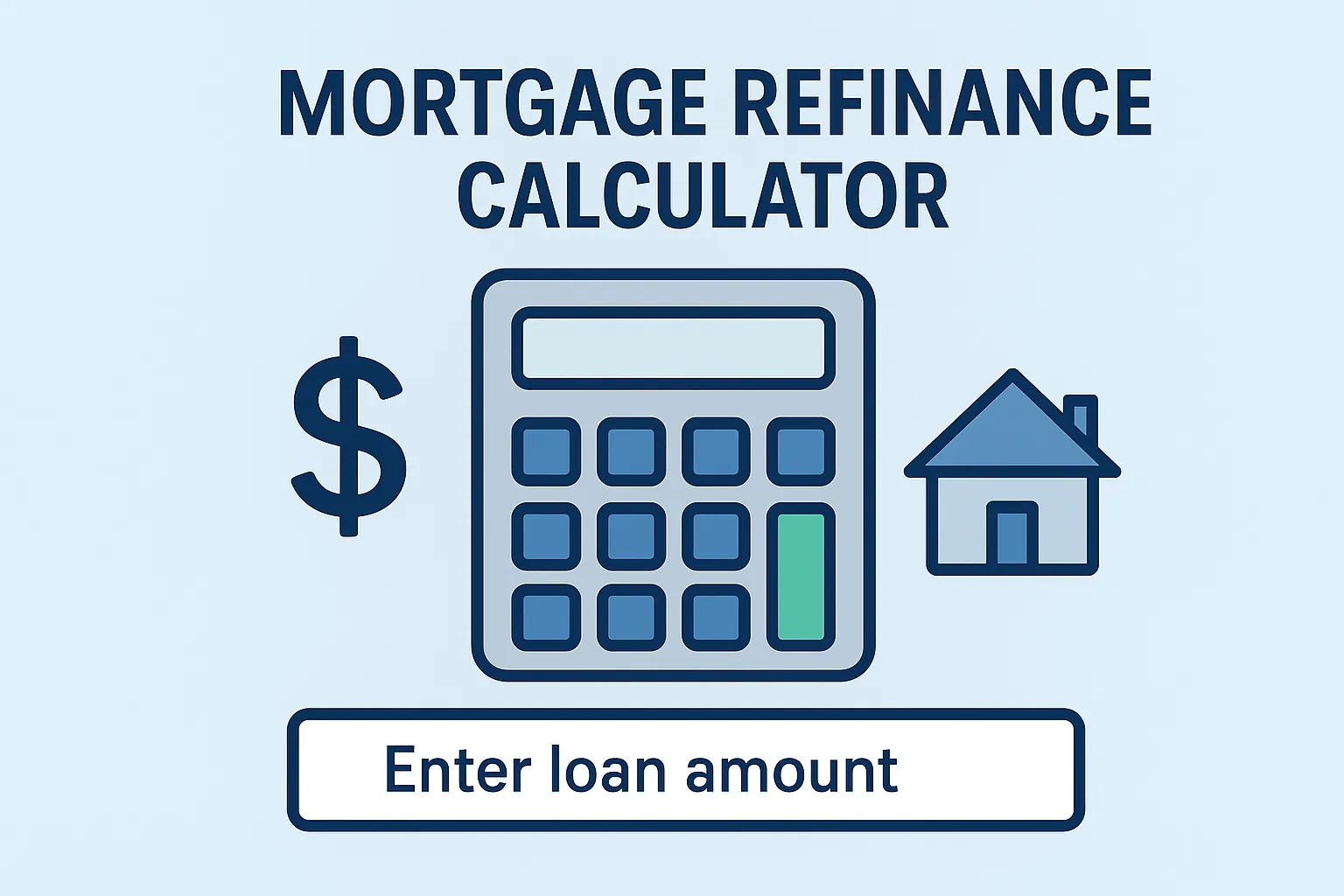When you see the phrase “mortgage refinance calculator,” it signals much more than just typing numbers into a tool. It’s about evaluating a major financial decision — whether replacing your current mortgage with a new one makes economic sense for you. In this guide, we’ll walk through what a mortgage refinance calculator is, how to use one, when it makes sense to refinance (and when it doesn’t), and how it connects with other parts of your financial life — from credit cards to business banking and savings accounts.
We’ll also integrate a number of related keywords — for example “best credit cards for bad credit,” “small business insurance quotes,” “personal loan for self‑employed,” “high‑yield savings account online,” plus various branded calculator terms like “Zillow refinance mortgage calculator,” “Rocket Mortgage refinance calculator,” “cash‑out refinance calculator,” etc. — so you can see how mortgage decisions tie into your broader financial picture.
Let’s begin.
Table of Contents
1. What is a Mortgage Refinance Calculator?
A mortgage refinance calculator is an online tool (or spreadsheet) that helps you estimate how much you might save — or lose — by refinancing your existing home‑loan into a new one. The goal isn’t just to lower your monthly payment; it’s to determine whether the benefits outweigh the costs of refinancing (closing fees, new term, etc.).
For example, the Bankrate refinance calculator explains that “refinancing a mortgage is all about the numbers. It can be a money‑saver for borrowers who can snag lower interest rates … but as you’re shopping around for lenders, crunch the numbers to make sure refinancing will save you money.” Bankrate
The Fannie Mae calculator likewise asks you to input your current mortgage balance, home value, loan‑to‑value (LTV), new interest rate, closing costs, etc., and then it shows your potential monthly and annual savings. Fannie Mae
Key Inputs
Here are the typical inputs you’ll need:
- Your current loan balance (what you still owe)
- The interest rate you’re paying now
- The remaining term or years left of your loan
- The home’s current estimated market value (so one can compute LTV)
- New loan interest rate you expect or have been quoted
- New loan term (e.g., 30 years, 15 years, or remaining years)
- Estimated closing costs / refinancing fees
- Whether you’re taking cash‑out (borrowing more than what you owe)
And then the calculator will output:
- New monthly payment (principal + interest)
- Monthly savings (old payment minus new payment)
- Annual savings
- Break‑even point (how many months/years until your upfront costs are recouped) Bankrate+2NerdWallet+2
Why it matters
Refinancing sounds appealing (lower rate → lower payment), but if the upfront costs are too high, if you plan to sell or move soon, or if you extend your loan term (thereby paying more interest over time), refinancing may not be worth it. Tools help you see the full picture rather than just the allure of a lower monthly payment.
2. When Does It Make Sense to Use a Mortgage Refinance Calculator?
You should use a mortgage refinance calculator whenever you are considering refinancing your home mortgage. Some common scenarios:
- Interest rates have fallen since you first took out your mortgage.
- Your credit score has improved significantly.
- You currently have an adjustable‑rate mortgage (ARM) and might want to switch to a fixed‑rate.
- You’ve built significant equity in your home and are thinking of a cash‑out refinance (taking extra cash out).
- You want to shorten your loan term (e.g., from 30 years to 15 years) and are willing to accept higher monthly payments for savings in interest.
- You are about to move or sell, and you want to see if refinancing still makes sense given the short holding period.
The calculator helps you answer questions like: “If I refinance now, how long must I stay in this home to break even?” and “Will I actually save money over the life of the loan?”
For example, NerdWallet notes: “By refinancing you will: reduce your monthly payment, or pay less interest over time — or both. But in most cases you’ll do one and not both.” NerdWallet
3. How to Use a Mortgage Refinance Calculator — Step‑by‑Step
Here’s a practical walk‑through:
Step 1: Gather your current loan information
- Check your latest statement: remaining principal, interest rate, original term, remaining years.
- Determine your home’s current value (via recent sale comparables or Zestimate if available).
- Check how long you expect to remain in your home.
Step 2: Get refinance quotes
- What interest rate can you qualify for now?
- What loan term do you want?
- Estimate closing costs (these vary, but calculators like Fannie Mae’s assume ~1.5% of loan amount as default). Fannie Mae
Step 3: Plug numbers into the refinance calculator
- Input your current loan and new loan assumptions.
- Review output: new monthly payment, interest savings, break‑even point.
Step 4: Interpret the results
- If the new monthly payment is lower and you get a better interest rate without drastically extending your term, good sign.
- Look at the breakeven period: e.g., if it shows you’ll break‑even in 36 months (3 years), and you plan to stay more than 3 years, refinancing may make sense. If you plan to move soon, maybe not. Bankrate+1
- Also evaluate long‑term interest cost: sometimes you reduce payments but extend term, which may increase total interest paid.
Step 5: Make your decision & shop lenders
- Compare multiple lenders, ask for loan estimates.
- Check if the costs (closing, points, fees) are justified.
- Confirm your credit score, loan‑to‑value ratio, debt‑to‑income ratio — these impact approval and rate. Bankrate
4. Branded Calculator Terms & What They Mean
You’ll often see calculations or tools with specific brand names. Here are some common ones, and why they matter:
- Zillow Refinance Calculator / Zillow Refinance Mortgage Calculator / Zillow Home Loans Rates: Zillow offers tools to estimate your refinance savings and current rate trends. Many homeowners use terms like “zillow refinance mortgage calculator” or “zillow home loans rates” when searching.
- Rocket Mortgage Refinance Rates Calculator / Rocket Mortgage Cash‑Out Refinance Calculator: Rocket Mortgage (by Quicken Loans) provides a branded calculator that lets you compare cash‑out vs rate‑and‑term refinance options.
- Simple Mortgage Refinance Calculator / Best Mortgage Refinance Calculator / Cash‑Out Refinance Calculator: These generic terms reflect your desire to find an easy tool that compares different refinance options.
Why pay attention to brand vs generic? Because brand calculators might integrate the lender’s own rate inventory, meaning results can be more tailored (but also may push that lender’s products). Generic calculators are good for estimates but you’ll still want to compare quotes across lenders.
5. Refinancing Options and Terminology
When using a mortgage refinance calculator, you’ll encounter different types of refinancing. Understanding them helps you use the tool more effectively.
Rate & Term Refinance
This is the most common: you replace your existing loan with a new one of similar or shorter term, ideally at a lower interest rate. The main goal: reduce monthly payment or pay off faster.
Cash‑Out Refinance
You borrow more than your current balance and take the difference in cash (for home improvements, debts, investments). A branded example: “rocket mortgage cash‑out refinance calculator.” Example: you owe $200,000, home value is $300,000, you refinance at $240,000 and receive $40,000 cash. The calculator will include the extra amount borrowed.
Cash‑In Refinance
Opposite of cash‑out: you pay down your principal (make a lump payment) and then refinance a lower balance, reducing your loan and often getting a better rate.
Break‑Even Point
This figure is crucial: the number of months it will take your monthly savings to cover the upfront costs of refinancing. If you sell or move before the break‑even point, you might lose money. Bankrate+1
6. Does Refinancing Always Make Sense?
No — and that’s the point of using a mortgage refinance calculator. Some scenarios where refinancing may not make sense:
- If the interest rate reduction is minor (say only a 0.25 % drop) but closing costs are high → break‑even may be many years away.
- If you plan to move in a few years, you might not stay long enough to reap savings.
- If you roll closing costs into your loan or extend the loan term, you may reduce monthly payment but pay more overall interest.
- If you have negative amortisation or your home value has dropped, LTV may be too high and refinancing may be harder or costlier.
For example, Investopedia discusses “7 Reasons Not to Refinance Your Mortgage,” noting that many homeowners neglect the upfront cost, the payoff period, and the long‑term interest implications. Investopedia
7. How Your Other Financial Products Tie Into Home Refinancing
Your mortgage isn’t an isolated product — it connects with many other parts of your financial life. Here’s how some of the secondary keywords relate:
Best Credit Cards for Bad Credit
If you have a lower credit score and are using a credit card aimed at rebuilding credit, your ability to get the best refinance rate may be limited. Improving your credit cards, paying down balances, and establishing on‑time payments can help your mortgage refinance eligibility and rates.
Small Business Insurance Quotes
If you run a business (or side hustle) and carry business insurance, this influences your debt‑to‑income ratio and overall financial profile. Lenders will look at your business obligations and how they impact your capacity to take on a refinanced loan.
Personal Loan for Self‑Employed
As someone who might be self‑employed (like you as a web designer and digital marketer), you may have non‑traditional income. When you refinance, lenders will scrutinise your documentation and may factor in any personal loans you have. Ensuring these don’t overload your debt commitments can support refinance approval.
High‑Yield Savings Account Online
Having a healthy savings account (especially one in a high‑yield online bank) shows lenders you’ve got reserves — this can improve your refinance application. Also, the savings amount might help you cover closing costs without borrowing them, improving your net savings.
Best Business Bank Accounts
As a business owner/designer, your banking relationship can matter. Clean business banking, stable income, minimal overdrafts, etc., feed into your overall financial health — something lenders consider when refinancing your home.
Car Insurance Comparison Online
While seemingly unrelated, if you’re paying high monthly premiums (e.g., car insurance) this affects your debt‑to‑income ratio. Using comparison tools to reduce those payments indirectly strengthens your refinance position.
8. How to Choose the Best Mortgage Refinance Calculator
With so many calculators out there (Zillow’s, Rocket Mortgage’s, generic ones), how do you pick? Here are some criteria:
- Accuracy of inputs: The calculator should allow you to enter closing costs, new rate, loan term, cash‑out (if any), etc.
- Break‑even calculation: Choose one that gives you the months/years until you recoup costs.
- Comparison of old vs new loan: Good tools show side‑by‑side: current loan vs proposed loan.
- Transparency: It should disclose assumptions (e.g., default closing costs assume 2%–3% of loan).
- Flexibility: Allow you to model multiple scenarios (15‑year vs 30‑year, fixed vs ARM).
- Reputable source: Big names like Bankrate, Fannie Mae, NerdWallet, etc. are reliable. For example, Bankrate’s tool is described as “an easy‑to‑use tool that helps estimate how much you could save by refinancing.” Bankrate
When you search for “best refinance calculator”, be cautious: some tools may push a particular lender’s product rather than provide a neutral estimate.
9. Step‑by‑Step Scenario Example
Let’s run a hypothetical example (numbers simplified) so you can see how things work in practice.
- Current loan balance: US $300,000
- Current rate: 6.00%
- Remaining term: 25 years
- Home estimated value: US $400,000
- Quote for new loan: rate = 4.50%, term = 25 years
- Closing costs estimate: 3% of loan amount ($9,000)
Plug into calculator → output might show:
- New monthly payment lower by say $150/month
- Annual savings = $1,800
- Break‑even = $9,000 / $150 ≈ 60 months = 5 years
Interpretation: If you plan to stay in the home at least 5 years, refinancing may make sense. If you expect to move in 2‑3 years, maybe not.
Also check: over the life of the loan, are you paying more interest (because you reset the term)? If yes, you might prefer a shorter term refinance (e.g., 20 years) if you can afford slightly higher payment.
10. Common Mistakes to Avoid
Here are pitfalls many homeowners fall into:
- Focusing only on monthly payment and ignoring closing costs or total interest.
- Extending the loan term (e.g., from 20 years remaining to 30 years) which lowers payment but increases total interest.
- Ignoring the break‑even period and refinanced, then move/sell before it’s reached.
- Not factoring in cash‑out amounts — taking more cash may raise rate or change term.
- Assuming you’ll qualify for the quoted rate — your credit health, income documentation, LTV matter.
- Ignoring other debts (credit cards, personal loans) that may interfere with refinance eligibility.
- Overlooking the fact that the interest rate drop has to be meaningful — small drops may not justify costs. For instance, a recent Kiplinger article suggests a drop of at least 0.75% may be needed to make refinance worthwhile in many cases. Kiplinger
11. How Refinancing Links to Your Long‑Term Financial Plan
Because you (the user) are a web‑designer, SEO specialist, teacher, digital marketer, and are interested in starting a large‑scale poultry farm — your financial world is broad. Here’s how refinancing fits in:
- Capital for growth: If your business (say the poultry farm) needs cash, a cash‑out refinance may be an option to tap home equity — but you must run the numbers carefully to ensure you’re not paying too much in long‑term cost.
- Income variability: Being self‑employed or having side‑hustles (teaching/web design) means lenders will want a stable income history. When refinance calculators give you output, you still need to verify your eligibility.
- Savings and backup: Having a strong high‑yield savings account (online) gives you the cushion to absorb unexpected costs (like closing costs, rate increases) and improves your financial standing.
- Debt management: If you have personal loans, business loans, credit cards (especially bad‑credit ones you may be using to rebuild), reducing those helps you qualify for lower mortgage rates when you refinance.
- Long‑term investment strategy: Perhaps you’re also thinking of investing in ETFs in 2025 (as you have a blog writing interest). If refinancing gives you better cash flow, you might use the extra savings to invest — but only if the refinance cost‑benefit is solid.
12. FAQs on Mortgage Refinance & Related Tools
Q1: What is the difference between a mortgage refinance calculator and a mortgage payment calculator?
A: A mortgage payment calculator tells you how much your payment will be for a given loan amount, interest rate, term. A refinance calculator compares your current mortgage with a new one, factoring in closing costs, break‑even, etc.
Q2: What is a cash‑out refinance calculator?
A: That’s a variant of the refinance calculator where you borrow more than the current balance and receive the difference as cash. The tool will compute how much extra payment you’ll have and how that affects savings/interest.
Q3: Should I refinance if I plan to move soon?
A: Only if your break‑even point is less than the time you’ll stay in the home. For instance, if costs are recouped in 2 years and you plan to stay 3, maybe yes. If you plan to move in 1 year and break‑even is 5 years, probably not. Bankrate
Q4: How often can I refinance?
A: Technically as often as you qualify and it makes sense—but each refinance incurs closing costs and may reset your term. Doing it too frequently may not be cost‑effective.
Q5: Do my credit cards, business insurance, savings account matter for refinancing?
A: Yes. Your credit score (influenced by how you manage credit cards) matters. Business expenses/insurance reflect your overall financial obligations. A good savings cushion supports your case. All affect your eligibility and rate.
13. Summary — Is It Time for You to Use a Mortgage Refinance Calculator?
Absolutely — especially if at least one of the following applies:
- You have a mortgage and current interest rate is significantly higher than today’s rates.
- Your credit score has improved since you took your loan.
- You have built meaningful home equity.
- You’re planning to stay in your home long enough to recoup costs (typically 2–5 years or more).
- You are self‑employed, have a business, or varied income and want to test whether refinancing is feasible financially.
By running scenarios in a mortgage refinance calculator (whether a generic one or a branded one like “Zillow refinance calculator” or “Rocket Mortgage refinance calculator”), you’ll gain clarity: how much you’ll save monthly, when you’ll breakeven, and whether refinancing fits your broader financial goals.
Given your background (digital marketer, web designer, teacher, planning poultry farm), you’re in a strong position to approach this with the analytical mindset you already use for SEO, data entry and system design. Treat the refinancing decision like a project—collect data, run scenarios, compare lenders, and ensure it aligns with the rest of your financial strategy (credit cards, savings, business banking, etc.).









